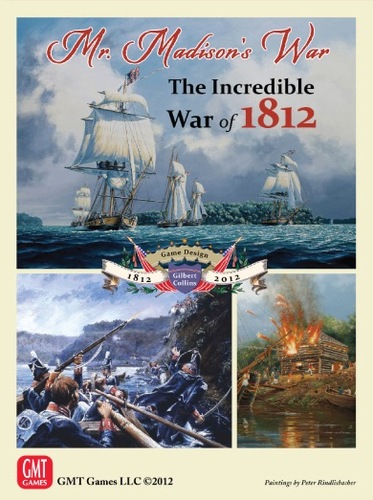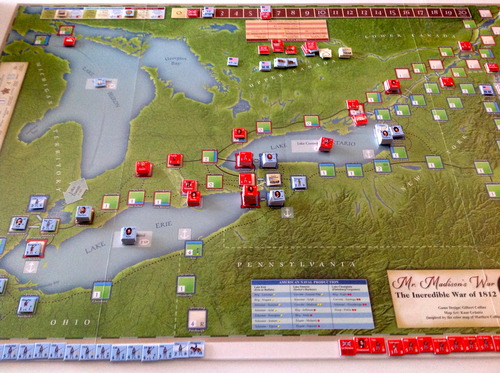|
Prova sul campo rappresenta “la voce” dei soci A.S.G.S. in merito a vecchie e nuove simulazioni che il mercato dei board-wargames offre. Una serie di pagine dove poter trovare piccole recensioni e/o resoconti di partite sui board-wargames che vengono giocati dal gruppo. “Perchè parlare di giochi è divertente come giocarci!!” – Anonimo
|
Da Wikipedia: Col nome Guerra del 1812 si indica il conflitto tra Stati Uniti d’America e Regno Unito iniziato il 18 giugno 1812, noto anche come Guerra americano-britannica per differenziarlo dalla guerra d’invasione della Russia da parte di Napoleone I Bonaparte, del medesimo anno.
James Madison, Presidente degli Stati Uniti, 1809-1817 Essa fu causata, per larga parte, dalla politica britannica di pressione nei confronti del popolo statunitense ed in particolare per l’obbligo imposto ai cittadini statunitensi di arruolarsi nellaRoyal Navy e per il blocco dei porti francesi interessati al commercio franco-americano. Sebbene i britannici avessero avuto la meglio nella maggior parte degli scontri fra i due eserciti, la maggior parte delle battaglie risentirono dello spirito del mito americano, compresa la battaglia di New Orleans, nella quale il generale statunitense Andrew Jackson inflisse ai britannici una delle più severe disfatte della loro storia. Ironicamente, la battaglia fu condotta due settimane dopo la conclusione del trattato di Gent, il quale pose fine alle ostilità e restaurò le condizioni anteguerra. Mr. Madison War GMT Games L’ultimo nato, fra i CardDriven pubblicati dalla GMT, tratta a dir poco un soggetto strano, perlomeno poco conosciuto: la guerra fra Stati Uniti e Gran Bretagna “all’interno” delle, invece, celebri campagne napoleoniche. Anche l’autore mi è sconosciuto: Gilbert Collins. Ad ogni modo la simulazione sembra già un discreto successo, perlomeno dalle prime recensioni e AAR apparse su siti specializzati.
Contenuti
Mappa formato standard, non cartonata, molto colorata. A prima vista la mappa colpisce per il colore verde……; completa di tabelle, turno di gioco e, naturalmente, le città (il classcio sistema “punto a punto”), collegate dai vari terreni.
Carte 110 le carte; suddivise in tre mazzi distinti, per l’anno 1812, 1813 e 1814. Ogni carta riporta poi i Punti Operativi, il tipo di carta, l’anno, il titolo della carta, il testo dell’evento e infine gli effetti della carta sul gioco. Devo dire che la prima impressione è quella di grande ricercastorica per gli eventi e le immagini (bellissime……).
Pedine e counters vari Le pedine presentano designazioni storiche; rosse per gli inglesi (naturalmente….) e azzurre per le truppe americane. Di dimensioni medie, riportano belle immagini delle unità militari e chiarissimi valori numerici che rappresentano valori di combattimento e classe delle unità.
Rule Book grande uso di colori, esempi e immagini per quello che sembra un regolamento scritto molto bene.
Play Book il libretto presenta 3 scenari, un ottimo esempio di gioco, le note storiche e quelle dell’autore.
Tabelle molto belle e complete le tabelle dedicate al combattimento e al movimento.
1D6 Di seguito, un’interessante valutazione da parte di un giocatore, tratta da BGG: The Game as a game: It is fun. It flows well. It is faster than other CDG’s I have played. And this brings us to the Winter turn. The Winter turn is really not a turn; it’s a speedbump. If you have held a winter card or two, okay, play them. Otherwise, it is a supply & attrition phase. This game forces you to tidy up those supply lines, and to be very careful about your forays into hostile territory; there are no fast-food restaurants and these people will not feed your enemy soldiers. Plan–PLAN–accordingly. The last two or three card plays before the winter turn might see a beehive of supply activity. One thing I especially like is how your fleets can battle for control of the Lakes (not that this is absent in that which shall not be named). The system is simple and straightforward, and control of the Lakes is vital for VP’s, and for starving or feeding an army, as well as transporting or invading with your troops. In Gilbert’s design, the ships, by name, are already assigned turns when they can reinforce your existing fleet; but not so fast; they have to be paid for through the use of OPS cards. Mr. Madison’s scope, and the movement allowances of land units, means that the buildups will be slow–historically slow. The War of 1812 demands an “offensive–defensive” strategy, which is reflected in Gilbert’s design. It does get rather annoyingly dull, however, to just have one army going eyeball to eyeball with another army because both sides are afraid that their opponent will do an end-around against whoever goes first. It is sort of like chicken in slow-motion. But this is a minor quibble, because there is normally some disaster in the making that is worthy of your attention, or that of your opponent. Oddities and Endities: Here are a few observations. First, only Brock and Tecumseh have the pleasure of having a bullet, or a tomahawk, with their names on it. But if they survive 1812, they won’t die. Well, Tecumseh can disappear if his Shawnee forces are wiped out. Second, leaders can be captured, but there is nothing set up for an exchange program. Or did I miss something? Third, Winfield Scott does not become a player in this game until 1814, entering as a one-star general. His impact was felt in 1812, and if the British had understood how borderline genius he was, they might not have released him–he was taken prisoner early on–until after the war. Last–I could find more, but none of these takes away from the solid design–there are too few leaders, limiting your options. Yes, I know that the coverage is not the same at that game which shall not be named–yet–but how about some optional leaders in a future GMT C3i? And toss in some optional rules, to add some chrome–did I mention how chrome free this game is?–while you are at it. How does Mr. Madison’s War compare to some other CDG’s? It is light-years better than either We the People or Washington’s War. It has the edge on For the People, if you like less chrome. If you want more chrome, than maybe you want FtP; but the leader rules in that design put the crack in the word crack, so let’s move on. Unhappy King Charles, designed by the Darth Vader of wargames, is among my favourites, and it will take many more places to see how Dolly Madison matches up with UKC. Mr. Madison is better than Stalin’s War, by gobs and gobs, and let us not mention WWII:BtB. Paths of Glory works superbly as a game, poorly as a simulation, unless one is re-enacting WWI on the planter Tedraigarb. Mr. Madison is far more secure in its historical footings, or footies, in the winter time. Which brings us to . . . The Game as History: The historical theme in MMW is more than just pasted on. It has a good feel for the events, two hundred years past them though we might be. But it is not a simulation, and Gilbert acknowledges as much. I do think it is a good introduction to the period, and to CDG’s in general. Links interessanti: http://www.armchairgeneral.com/mr-madisons-war-the-incredible-war-of-1812-boardgame-review.htm
Seguiranno ulteriori personali valutazioni dopo le prime partite!
|
| € 58,00 | GMT Games |
Marzo 2013: Mr. Madison War





